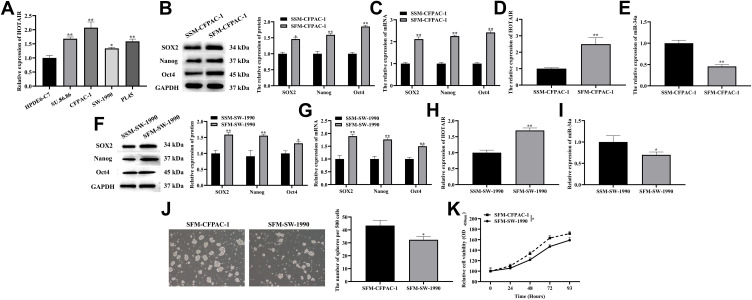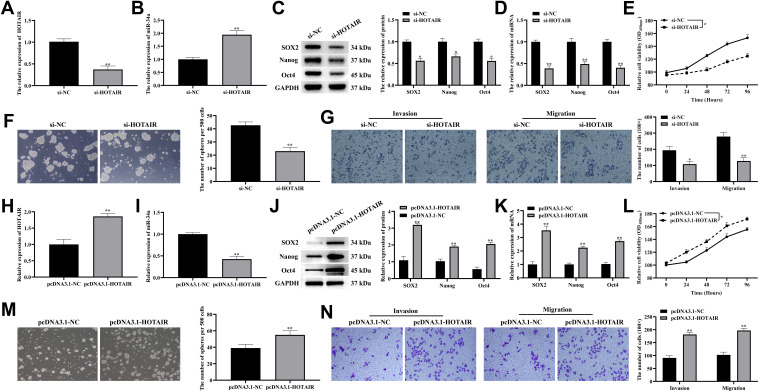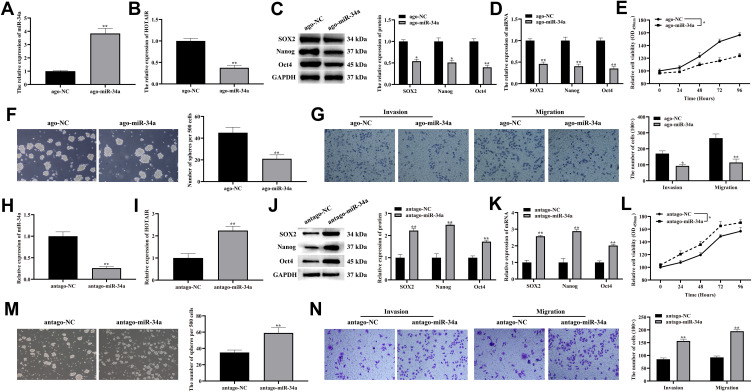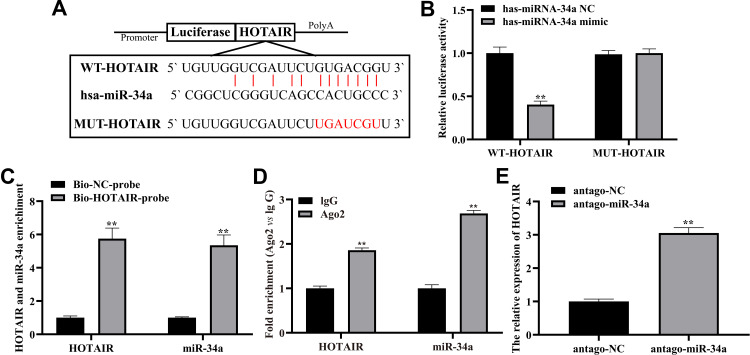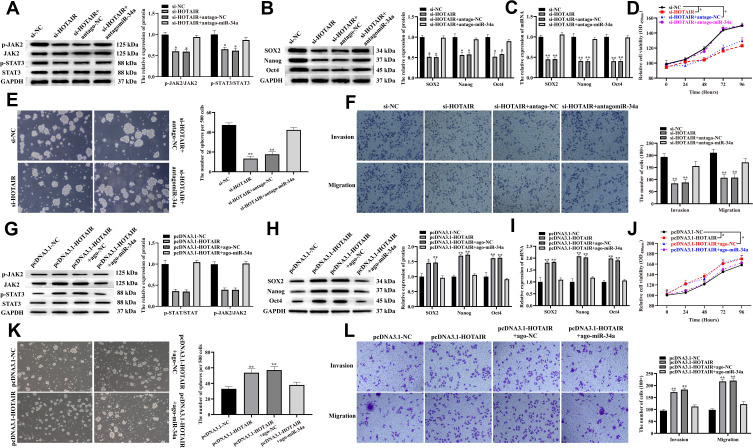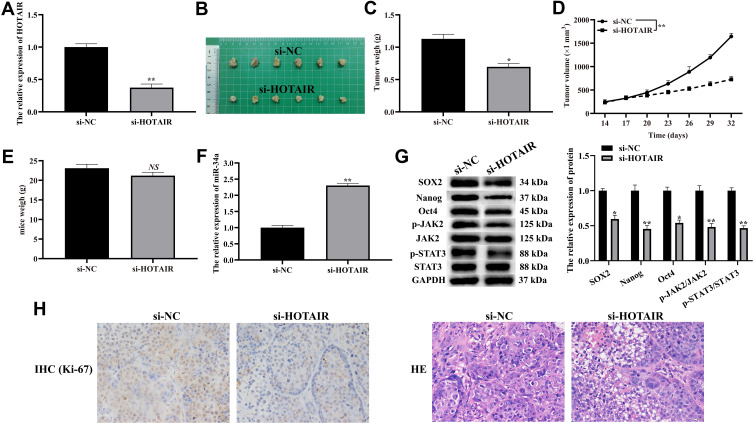Abstract
Introduction
Pancreatic Ductal Adenocarcinoma (PDAC) stem cells (CSCs) play a vital role in the occurrence, development and recurrence of PDAC. Previous studies have shown that long non-coding RNAs (lncRNA) are closely associated with occurrence and development of malignant tumors. Among them, a LncRNA called homeobox transcription antisense RNA (HOTAIR) plays a key role in cancer progression in a variety of malignant tumors, including PDAC. Numerous studies have associated HOTAIR with poor prognosis of malignant tumor treatment, owing to its role in regulating downstream microRNAs (miRNAs). However, its underlying mechanism of action on CSCs-like properties of PDAC remain unclear.
Methods
We enriched CSCs of PDAC with a serum-free medium (SFM), and analyzed the expression levels of HOTAIR and miR-34a after enrichment. In addition, we evaluated the regulatory effects of HOTAIR and miR-34a on CSCs-like properties, invasion and migration of PDAC. Finally, we elucidated the role of HOTAIR in pancreatic tumor xenotransplantation.
Results
HOTAIR was upregulated in CSCs following PDAC enrichment of PDAC. Conversely, miR-34a was downregulated and appeared to be a direct target of HOTAIR. Moreover, knocking down HOTAIR or overexpressing miR-34a significantly inhibited CSCs-like properties, invasion and migration of PDAC cells. Furthermore, HOTAIR activated the JAK2/STAT3 pathway through miR-34a, thereby promoting CSCs-like properties, invasion and migration of PDAC cells. In vivo experiments indicated that knocking down HOTAIR could inhibit the tumorigenicity of CFPAC-1 cells.
Conclusion
This is the first report of HOTAIR-mediated activation of the JAK2/STAT3 pathway via miR-34a inhibition. This activation promotes CSCs-like properties, invasion and migration of PDAC.
Keywords: pancreatic ductal adenocarcinoma, lncRNA HOTAIR, miR-34a, CSCs-like properties, JAK2/STAT3 pathway
Introduction
Pancreatic cancer (PC) is a malignant tumor of the digestive tract, with about 90% of it originating from PDAC of the ductal epithelium.1 PDAC is the third leading cause of cancer-related deaths in the United States,2 with estimates indicating that it will become the second leading cause of cancer-related deaths in the country after lung cancer, by 2030.3 The Surveillance, Epidemiology and End Results (SEER) dataset indicates that patients with advanced PDAC have a five-year survival rate of is only 8.5%.4 Currently, chemotherapy and radiotherapy are the main treatment therapies for PDAC, although they are characterized by poor prognosis while the 5-year survival rate of patients has not significantly improved.5 Therefore, urgent discovery of novel and effective treatment therapies for PDAC is needed to improve prognosis and patient survival.
Previous studies have shown that some cells manifest stem cell-like characteristics, across a variety of malignant tumors, and are therefore cancer stem cells (CSCs).6 In 2006, the American Association for Cancer Research defined CSCs as cells in tumors that can self-renew and can cause a heterogeneous line of cancer cells that make up the tumor.7 However, some studies have shown that CSCs are resistant to chemotherapy and radiotherapy, and are therefore considered the main cause of tumor recurrence.8 Exploration of CSCs-based treatment of PDAC may be of great significance in managing the tumors. Non-coding RNAs (ncRNAs) transcripts with coding domain in the genome but most of which are not translated into protein, have been shown to play a key role in the physiological functions of various cells. Specifically, long non-coding RNAs (lncRNAs) play an important regulatory role in chromatin dynamics, gene expression, cell growth and differentiation. Previous studies have demonstrated that homeobox transcription antisense RNA (HOTAIR) has been widely confirmed to play a role as a cancer-promoting factor in a variety of tumors including PDAC, and has an important regulatory effect on CSCs across various tumors.9–11 For example, Deng et al showed that HOTAIR could promote proliferation, clone formation, invasion and self-renewal of breast cancer CSCs.12 Other research works have shown that LncRNA-targeted regulation of miRNA is one of the main ways of tumor development, with miR-34a found to regulate CSCs-like properties in a variety of tumors.13–15 To date, however, nothing is known regarding whether HOTAIR regulates PDAC CSCs-like properties by targeting miR-34a. Furthermore, extensive local tumor invasion and early systemic dissemination are one of the main characteristics of PDAC.16 In the present study, we explored the HOTAIR’s effect on CSCs-like properties, invasion and migration of PDAC, with the aim of providing insights to guide development of novel treatment therapies for PDAC.
Materials and Methods
Cell Lines and Establishment of Cell Cultures
Human normal ductal epithelial cells (HPDE6-C7) and PDAC cells (SU.86.86, CFPPAC-1, SW-1990 and PL45) were purchased from the Cell Bank of Shanghai Institute of Cell Biology, Chinese Academy of Science (Shanghai, China). The cells were cultured in RPMI-1640 medium (Gibco, Carlsbad, CA, USA), supplemented with 10% FBS, 100 U/mL penicillin, and 0.1 mg/mL streptomycin and incubated in a humid chamber maintained at 5% CO2 and a temperature of 37°C.
Cell Transfection
Small interfering RNAs (siRNAs) targeting HOTAIR (si-HOTAIR), control siRNA (si-NC), pcDNA3.1-HOTAIR and control pcDNA3.1 (pcDNA3.1-NC) were purchased from Ribobio (Guangzhou, China). miR-34a agomiR (ago-miR-34a), miR-34a antagomiR (antago-miR-34a) and miRNA ago/antago control (ago-NC/antago-NC) were designed and synthesized by Shanghai GenePharma Co., Ltd. (Shanghai, China). Transfection was performed using Lipofectamine 2000 (Invitrogen, Carlsbad, CA, USA), according to the manufacturer’s instructions.
RNA Extraction and Quantitative Real-Time PCR (qRT-PCR)
Trizol reagent (Invitrogen, USA) was used to extract total RNA from cells according to the instructions. Complementary DNA (cDNA) was synthesized using the SuperScript III Reverse Transcriptase Kit (Thermo Fisher Scientific, USA), then subjected to qRT-PCR using the UltraSYBR Mixture Kit (Sangon Biotech, Shanghai, China). qRT-PCR reaction was performed in an ABI StepOne cycler (ABI, Foster City, CA, USA), under the following conditions; an initial denaturation at 95°C for 1 min, 35 cycles of denaturation at 95°C for 1 min, annealing at 60°C for 2 min, and extension for 30s, at 72°C. Results of the log-linear phase of the growth curve were analyzed and relative quantification performed using the 2−ΔΔCT method with GAPDH as an internal amplification control. Primers used in the amplification are listed in Table 1.
Table 1.
Primers Used in RT-qPCR
| Name | Forward Primer (5′-3′) | Reverse Primer (5′-3′) |
|---|---|---|
| miR-34a | GCTGTGAGTGTTTCTTTGGCA | ACGTGCAGCACTTCTAGGG |
| U6 | CCCTTCGGGGACATCCGATA | TTTGTGCGTGTCATCCTTGC |
| HOTAIR | CCTACAAAGCCCTCTCTCCC | ATCATAGCGGTCCTGGCTTG |
| SOX2 | AACCAGCGCATGGACAGTTA | GACTTGACCACCGAACCCAT |
| Nanog | GTGTGACGCAGGTAACAGGA | TGTGTGTTTCAGGGATGGACA |
| Oct4 | TGGTAAGTTCATCGGGACCA | CCCATTAGGCGGTCCAAGTT |
| GAPDH | GCAACTAGGATGGTGTGGCT | TCCCATTCCCCAGCTCTCATA |
Protein Extraction and Western Blotting Assay
To extract proteins, CFPAC-1 and SW-1990 cells were first lysed with RAPI protein lysis buffer (Promega, USA) for 30 min, scraped and transferred into a pre-chilled 1.5 mL EP tube, then centrifugation. The supernatant was quantified using the BCA kit for quantification, then separated on a 10% SDS-PAGE gel. The contents were blocked with 5% skimmed milk powder at room temperature for 2 hours, transferred to PVDF membranes, then incubated overnight with primary antibodies, namely SOX2 (1:1000; abcam, UK), Nanog (1:1000; abcam, UK) and Oct4 (1:1000; abcam, UK) at 4°C. The following day, TBST washed 3 times, with 5 min at each time, then incubated with Goat Anti-Rabbit IgG H&L (1:3000; abcam, UK), and blocked at room temperature for 1 h. Finally, an ECL chemiluminescence solution (Thermo Fisher Scientific, USA) was added followed by visualization on an imaging system. Protein bands in the obtained images were analyzed using Image J software.
CCK-8 Assay
CFPAC-1 and SW-1990 cells proliferation assay was performed using a Cell Counting Kit-8 (CCK-8; Dojindo, Kumamoto, Japan). According to the manufacturer’s protocol, the cells were seeded in a 96-well plates, with a total volume of each well set at 100 μL (1×105 cells in each well), with three repeats wells for each group. The cells were transfected for 24 h, 10μL of CCK-8 solution added to each well, then the plates placed in a humidified incubator maintained at 37°C with 5% CO2. Optical Density (OD) values were recorded after 0, 24, 48, 72, 96 h of culture, followed by measurement of absorbance at 450 nm wavelength on a microplate reader (Molecular, USA).
Sphere Formation Assay
CFPAC-1 and SW-1990 cells were cultured in a serum-free medium (SFM), containing DMEM/Ham Nutrient Mixture F-12 (1:1), and 20 ng/mL epidermal growth factor, 10 ng/mL human fibroblast growth factor basic and 2% B-27 for 14–21 days. Thereafter, cell spheres were counted using the TE2000-U inverted microscope (Nikon, Japan), with a diameter greater than 40 μm, and images captured.
Transwell Assay
Matrigel and serum-free RPMI-1640 medium was prepared, at a ratio of 1:3 and spread it in the upper chamber of Transwell (only required for the invasion experiment, and the subsequent invasion and migration experiments are the same). CFPAC-1 and SW-1990 cells, at a logarithmic phase were trypsinized and seeded in a 24-well plate in a Transwell chamber. Thereafter, 100 μL of cell suspension was added to the upper chamber, whereas 250 μL of RPMI-1640 containing 10% fetal bovine serum was added to the lower chamber, and the CFPAC-1 and SW-1990 cells incubated at for 48 h 37°C and 5% CO2. After staining with crystal violet for 15 minutes, then those under the microporous membrane of the chamber were fixed with 4% paraformaldehyde for 15 minutes. The chamber was rinsed with PBS, dried and placed on an inverted microscope for observation.
Dual-Luciferase Reporter Gene Assay
We transfected 200 ng/mL plasmid vectors of wild-type HOTAIR-WT-3ʹ-UTR and mutant-type HOTAIR-MUT-3ʹ-UTR into 293T cells, for 48 h, discarded the original cell culture medium, then added 35 μL/well of fresh culture medium to each well. Thereafter, we added 35 μL/well of Luciferase substrate to each well, then measured its absorbance using a microplate reader. Finally, we added 30 μL of Stop regents, and measured cell absorbance using a microplate reader.
RNA Pull-Down Assay
DNA fragments containing full-length TUG1 or the negative control sequences were amplified by PCR, using primers containing t7. The resulting fragments were cloned into a plasmid vector GV394 (Genechem, China), which had been linearized by XhoI digestion. Reverse transcription of biotin-labeled RNA was performed using T7 RNA polymerase (Takara Biomedical Technology, Japan) and biotin RNA labeling mixture (Roche, USA). RNA was extracted using the RNeasy Mini Kit (Qiagen, USA), treated with RNase-free DNase I (Roche, USA), then subjected to qRT-PCR as previously described above.
In vivo Tumorigenicity Assay
All studies involving mice were approved by the Animal Experiment Ethics Review Committee of Kunming Medical University (No. kmu-eac-2017248). The experimental procedures were performed in strict adherence to the “Guidelines for the Care and Use of Laboratory Animals” of the Chinese Institute of Health. We purchased 6-8-week-old female BALB/c nude mice from the Guangdong Medical Laboratory Animal Center, China. The mice were maintained and fed in a small room with a light/dark cycle of 12 h, a temperature of 22±2°C, and a relative humidity of 55±5%. All mice were divided into the si-NC and si-HOTAIR groups, with 6 mice in each group, then CFPAC-1 cells transfected with si-HOTAIR as well as their corresponding negative controls subcutaneously injected into them. Emerging tumors were monitored every 3 days using a Vernier caliper and tumor volumes (V) calculated. Body weights were also used to monitor the health of animals. After 32 days, the mice were anesthetized with 1% 75 mg/kg sodium pentobarbital and sacrificed by cervical dislocation. Tumors in each mouse were then weighed and recorded.
Statistical Analysis
All data were statistically analyzed using SPSS 20.0 software. Comparisons between two groups were performed using a t test, whereas those among multiple groups was conducted by single-factor analysis of variance (ANOVA). Graphs were generated using GraphPad Prism 7 software. P<0.05 or P<0.001 was considered statistically significant.
Results
HOTAIR and miR-34a are Abnormally Expressed in CSCs of PDAC
Differential expression analysis of HOTAIR in HPDE6-C7, SU.86.86, CFPPAC-1, SW-1990 and PL45 cells revealed significant upregulation of HOTAIR in PDAC relative to HPDE6-C7 cells (Figure 1A). Among these PDAC cells, the highest and lowest HOTAIR expression was observed in CFPAC and SW-1990 cells, respectively. Consequently, we cultured CFPAC and SW-1990 cells in SFM, then performed Sphere formation assay to enriched CSCs. We also performed Western blot and qRT-PCR analyses to detect expression levels of SOX2, Nanog and Oct4 of CSCs markers.17 Results revealed significant upregulation of SOX2, Nanog and Oct4 protein and mRNA in CFPAC or SW-1990 cells cultured in SFM, relative to those cultured in SSM (Figure 1B, C, F and G). We also observed significant upregulation of HOTAIR in the SFM-CFPAC-1 or SFM-SW-1990 group, relative to that in SSM-CFPAC-1 or SSM-SW-1990 groups (Figure 1D and H), while an opposite expression pattern was observed in miR-34a (Figure 1E and I). Furthermore, the number of spheres (Figure 1J) and proliferation (Figure 1K) were significantly higher in CFPAC than SW-1990 cells. Overall, these findings indicate that HOTAIR is overexpressed in CSCs of PDAC, whereas miR-34a exhibits an opposite pattern. Therefore, HOTAIR and miR-34a maybe regulating CSCs-like properties.
Figure 1.
Profiles of HOTAIR and miR-34a expression in CSCs of PDAC.
Notes: (A) qRT-PCR results indicating HOTAIR expression in human normal ductal epithelial cells (HPDE6-C7) and PDAC cells (SU.86.86, CFPPAC-1, SW-1990 and PL45). (B and C) SSM-/SFM-CFPAC-1 and (F and G) SSM-/SFM-SW-1990 cells. Expression of CSCs markers, SOX2, Nanog and Oct4 were detected by Western bolt and qRT-PCR, respectively. Levels of HOTAIR and miR-34a expression detected via qRT-PCR in SSM-/SFM-CFPAC-1 (D and E) and SSM-/SFM-SW-1990 cells (H and I). Sphere formation assay of CFPAC-1 (J) and SW-1990 cells cultured in SFM (J); spheres (>40 μm in diameter) were counted. (K) CCK-8 assay was performed to detect cell proliferation. Error bars: means ± SD (n=3 for each group). *P<0.05; **P<0.01 versus SSM-CFPAC-1 or SSM-SW-1990 group.
Knocking Down HOTAIR Inhibits CSCs-Like Properties, Invasion and Migration of PDAC
To understand the effect of the abnormal HOTAIR expression on CSCs-like properties of PDAC, we transfected si-HOTAIR or pcDNA3.1-HOTAIR into CFPAC-1 or SW-1990 cells, then analyzed changes in CSCs-like properties. qRT-PCR results revealed a significant HOTAIR downregulation (Figure 2A) or up-regulation (Figure 2H), following si-HOTAIR or pcDNA3.1-HOTAIR transfection, whereas an opposite pattern was observed with regards to miR-34a (Figure 2B and I). Analysis of HOTAIR’s effect on expression of CSCs markers revealed that this LncRNA significantly promoted the levels of SOX2, Nanog and Oct4 proteins and mRNA in CFPAC-1 (Figure 2C and D) as well as SW-1990 cells (Figure 2J and K). Analysis of proliferation and spheroidization ability of CFPAC-1 and SW-1990 cells revealed that knocking down HOTAIR inhibited proliferation and the number of spheres of PDAC cells (Figure 2E and F), while its overexpression generated an opposite pattern (Figure 2L and M). We also investigated HOTAIR’s effect on invasion and migration, since extensive local tumor infiltration and early systemic dissemination represent the main characteristics of PDAC. Results from the Transwell assay showed significantly higher rates of invasion and migration in CFPAC-1 cells in the si-HOTAIR than in the si-NC group (Figure 2G). However, the rate of invasion and migration of SW-1990 cells in the pcDNA3.1-HOTAIR group was significantly higher than in the pcDNA3.1-NC group (Figure 2N). Overall, these results indicate that HOTAIR regulates development of PDAC by promoting CSCs-like properties, invasion and migration of CFPAC-1 cells.
Figure 2.
Knocking down HOTAIR inhibited CSCs-like properties, invasion and migration in PDAC.
Notes: Levels of HOTAIR and miR-34a expression were detected via qRT-PCR in CFPAC-1 (A and B) and SW-1990 cells (H and I). Levels of expression of CSCs markers, SOX2, Nanog and Oct4 in CFPAC-1 (C and D) and SW-1990 cells (J and K), were detected via Western blots and qRT-PCR, respectively. (E and L) Cell proliferation detected via CCK-8 assay. (F and M) Detection of sphere formation; spheres (>40 μm in diameter) were counted. (G and N) Detection of invasion and migration of SFM-CFPAC-1 and SFM-SW-1990 cells using the Transwell assay. Error bars: means ± SD (n=3 for each group). *P<0.05; **P<0.01 si-NC or pcDNA3.1-NC group.
Overexpressing miR-34a Inhibits CSCs-Like Properties, Invasion and Migration of PDAC
Considering miR-34a’s abnormally low expression in SFM-CFPAC-1 and SFM-SW-1990 cells (Figure 1E and I), we hypothesized that HOTAIR could be regulating miR-34a expression (Figure 2B and I). Consequently, we explored miR-34a’s effect on CSCs-like properties, invasion and migration of PDAC cells. qRT-PCR results showed that, miR-34a was significantly up-regulated or down-regulated, relative to with ago-NC or antago-NC (Figure 3A and H), while HOTAIR was the opposite (Figure 3B and I). Notably, HOTAIR and miR-34a appeared to interact. Western blot and qRT-PCR showed that significantly lower SOX2, Nanog and Oct4 levels in the ago-miR-34a group relative to ago-NC (Figure 3C and D), whereas those in the antago-miR-34a group were significantly higher than those of antago-NC (Figure 3J and K). Furthermore, results from the CCK-8 and Sphere formation assays showed that overexpressing miR-34a promoted proliferation and number of spheres in CFPAC-1 cells (Figure 3E and F), while knocking it down caused an opposite reaction (Figure 3L and M). Analysis of miR-34a’s effect on the invasion and migration of PDAC cells showed that overexpressing this miRNA significantly inhibited both processes (Figure 3G), whereas knocking it down promoted invasion and migration (Figure 3N). These results indicate that miR-34a inhibits CSCs-like properties, invasion and migration of PDAC cells, possibly by interacting with HOTAIR.
Figure 3.
Overexpressing miR-34a inhibited CSCs-like properties, invasion and migration of PDAC.
Notes: Levels of miR-34a and HOTAIR expression in each group of CFPAC-1 (A and B) and SW-1990 cells (H and I) were detected by qRT-PCR. (C, D, J and K) The expression of CSCs markers, SOX2, Nanog and Oct4 were detected by Western bolt and qRT-PCR in each group, respectively. (E and L) CCK-8 assay was performed to detect the cell proliferation. (F and M) Sphere formation assay was performed to detect the sphere formation; spheres (>40 μm in diameter) were counted. (G and N) Transwell assay was performed to detect invasion and migration. Error bars: mean ± SD (n=3 for each group). *P<0.05; **P<0.01 ago-NC or antago-NC group.
HOTAIR Directly Targets miR-34a
Since numerous studies have shown that LncRNAs directly target miRNAs to regulate expression of miRNA. We hypothesized that HOTAIR could be interacting with miR-34a. Consequently, we performed a predictive analysis targeting the Starbase bioinformatics database, and found that HOTAIR and miR-34a have targeted binding sequences (Figure 4A). Verification of the targeting relationship between HOTAIR and miR-34a through dual-luciferase reporter gene assay showed that miR-34a could significantly inhibit luciferase activity of wild-type, but had no significant effect on that of mutant-type HOTAIR (Figure 4B). Subsequently, we used RNA pull-down assay to further explore whether HOTAIR directly interacts with miR-34a. qRT-PCR results revealed that the pellet pulled down by HOTAIR contained a large amount of miR-34a (Figure 4C). Previous studies have also shown that a miRNA exerts its gene silencing effect through RNA-induced silencing complex (RISC), and Ago2 is a core component of RISC.18 Based on this, we performed an Ago2-RIP assay to verify whether HOTAIR and miR-34a are components of the same RISC. Summarily, qRT-PCR analysis on RNA extracted from composite precipitates revealed significantly higher levels of HOTAIR and miR-34a in the AGO2 than in the lgG group (Figure 4D). Furthermore, knocking down miR-34a significantly upregulated HOTAIR (Figure 4E). These results indicate that miR-34a is a direct target of HOTAIR, and that HOTAIR can negatively regulate miR-34a expression.
Figure 4.
HOTAIR directly targets miR-34a.
Notes: (A) Starbase bioinformatics database predicted the binding region of HOTAIR and miR34a. (B) The targeting relationship between HOTAIR and miR-34a verified by Dual-luciferase reporter gene assay. (C) Profiles of HOTAIR and miR-34a in the same sample pulled down by biotinylated HOTAIR and negative control (NC) probes, detected via qRT-PCR. (D) Determination of HOTAIR’s and miR-34a’s binding ability on Ago2 based on the Ago2-RIP assay. (E) The expression levels of HOTAIR were detected by qRT-PCR. Error bars: means ± SD (n=3 for each group; **P<0.01).
HOTAIR Promoted CSCs-Like Properties, Invasion and Migration by Regulating miR-34a to Activate the JAK2/STAT3 Pathway in PDAC
Many studies have demonstrated the regulatory effect of the JAK2/STAT3 pathway in CSCs.19–21 Based on this, we explored the effect of HOTAIR on JAK2/STAT3 pathway through miR-34a. Western blot showed that HOTAIR significantly up-regulated phosphorylation of STAT3 and JAK2 in PDAC cells, while miR-34a inhibited HOTAIR’s effect on the JAK2/STAT3 pathway (Figure 5A and G). Analysis of HOTAIR’s effect on CSCs properties in PDAC cells by the miR-34a/JAK2/STAT3 pathway revealed that miR-34a blocked the effect of this LncRNA on the expression of SOX2, Nanog and Oct4 in this group of cells (Figure 5B, C, H and I). Results from the CCK-8 and Sphere formation assays showed that knocking down or overexpressing HOTAIR significantly inhibited or promoted proliferation and spheroidization ability of PDAC cells, whereas co-knockdown or co-overexpression of both HOTAIR and miR-34a restored these phenotypes (Figure 5D, E, J and K). A further analysis of HOTAIR’s effect of HOTAIR on invasion and migration of CFPAC-1 cells, via the miR-34a/JAK2/STAT3 pathway, using the Transwell assay revealed a significant downregulation (Figure 5F) or up-regulation (Figure 5L) in the number of invasion and migration of PDAC cells in the si-HOTAIR or pcDNA-3.1-HOTAIR, relative to that in the si-NC or pcDNA-3.1-NC, groups. Co-knockdown or co-overexpression of HOTAIR and miR-34a resulted in no significant differences in the number of invasion and migration in CFPAC-1 cells in the si-NC (Figure 5F) or pcDNA-3.1-NC (Figure 5L). Overall, these results indicate that HOTAIR activates the JAK2/STAT3 pathway by inhibiting miR-34a expression, thereby promoting the CSCs properties, invasion and migration of PDAC cells.
Figure 5.
HOTAIR promoted CSCs properties, invasion and migration by interacting with miR-34a to activate the JAK2/STAT3 pathway in PDAC.
Notes: Western blots indicating levels of p-STAT3 and p-JAK2 expression of CFPAC-1 (A) and SW-1990 cells (G) in each group. (B, C, H and I) Expression levels of CSCs markers, SOX2, Nanog and Oct4 in each group, detected using qRT-PCR and Western blot assays. (D and J) Proliferation activity detected via the CCK-8 assay. (E and K) Sphere formation; spheres (>40 μm in diameter) were counted. (F and L) Invasion and migration detected using the Transwell assay. Error bars: mean ± SD (n=3 for each group). *P<0.05; **P<0.01 si-NC and pcDNA3.1-NC group.
Knocking Down HOTAIR Inhibits Tumorigenicity of CFPAC-1 Cells
We established a CFPAC-1 cell model that stably knockdown HOTAIR and injected these cells subcutaneously into nude mice to explore the tumorigenicity of HOTAIR in vivo. qRT-PCR results revealed significantly lower HOTAIR levels in tumor tissues of si-HOTAIR than those in the si-NC group (Figure 6A). Analysis of tumors in the mice, 32 days after injection (Figure 6B), revealed significantly higher mass and volumes in the si-HOTAIR than in the si-NC group (Figure 6C and D). However, we observed no significant differences in the mass of tumors in nude mice (Figure 6E). Moreover, miR-34a was significantly upregulated in the si-HOTAIR relative to the si-NC group (Figure 6F), whereas SOX2, Nanog, Oct4, p-STAT3 and p-JAK2 were all downregulated (Figure 6G). Furthermore, IHC results showed that knocking down HOTAIR significantly inhibited Ki-67 expression (Figure 6H). These results indicate that knocking down HOTAIR significantly inhibits tumorigenicity of CFPAC-1 cells.
Figure 6.
Knocking down HOTAIR inhibited tumorigenicity of CFPAC-1 cells.
Notes: (A) qRT-PCR was used to detect the expression levels of HOTAIR in si-NC and si-HOTAIR groups. (B) Tumor diagram of si-NC and si-HOTAIR groups. (C and D) Tumor mass and volume of si-NC and si-HOTAIR groups. (E) The mass of nude mice in si-NC and si-HOTAIR groups. (F) qRT-PCR was used to detect the expression levels of miR-34a in si-NC and si-HOTAIR groups. (G) Western blot was used to detect the expression levels of protein in si-NC and si-HOTAIR groups. (H) IHC (Ki-67) and HE staining of tumor tissues in si-NC and si-HOTAIR groups. Error bars: mean ± SD (n=6 for each group). *P<0.05; **P<0.01 si-NC group.
Discussion
PDAC is one of the most common types of PC, a malignant tumor characterized by a high fatality rates and very poor prognosis. According to statistics from the American Cancer Society, the number of PDAC patients as well as the associated deaths are 44,330 people affected every year.22 Previous studies have shown that CSCs are self-renewing tumor cells, which can be identified in most types of malignant tumors, and contribute to tumor onset, development, drug resistance, recurrence and metastasis after treatment.23 Based on these reports, targeted CSCs therapy may be a breakthrough in tumor therapy. In the present study, we adopted a method by Zhu et al to separate CSCs in PDAC by SFM and found that CSCs enriched in SFM had more abundant SOX2, Nanog and Oct4 of CSCs markers. In addition, we observed abnormal upregulation of HOTAIR in the CSCs enriched in SFM, while miR-34a was the opposite. Based on these results, we subsequently evaluated the effects of HOTAIR and miR-34a on CSCs-like properties, invasion and migration of CFPAC-1 cells, then validated the findings using in vivo experiments.
Many studies have associated LncRNAs with a variety of cancers, including prostate, breast, gastric, lung, and liver cancers. It has been confirmed that the highly expressed HOTAIR is an important predictor of breast cancer metastasis and poor prognosis.24 In addition, HOTAIR is up-regulated in human non-small cell lung cancer (NSCLC), where it induces migration and growth of NSCLC cells in vitro.25 Apart from this, HOTAIR was associated with progression and prognosis of hepatocellular carcinoma.26 In this study, we found that knocking down HOTAIR could inhibit CSCs-like properties, invasion and migration of CFPAC-1 cells, consistent with a previous study that reported that HOTAIR had an inhibitory effect on tumor growth in head and neck squamous cell carcinoma mouse xenograft tumor model.27 This study also evaluated HOTAIR’s role in tumor development in vivo. Knocking down HOTAIR reduced the mass and volume of tumors, and could downregulate SOX2, Nanog, Oct4 and Ki-67 in tumor tissues, affirming its role in inhibition of tumor growth in vivo. Our results also indicated that HOTAIR targeted miR-34a, and negatively regulated its expression levels.
Apart from acting as a tumor suppressor in a variety of cancers, miR-34a has been shown to play an important regulatory role in cancer initiation, progression and treatment.28 Previous studies have shown that compared with normal PDAC cells, miR-34a expression in PDAC cells is significantly reduced.29 In addition, miR-34a is closely related to HOTAIR in cancer. For example, a recent study proved that HOTAIR has a physical effect with the miR-34a promoter.30 Among the subpopulations of CSCs enriched in breast cancer cells, HOTAIR targets miR-34a to inhibit miR-34a, leading to the up-regulation of Sox2.12 Moreover, miRNAs are thought to play an important role in the regulation of CSCs. In this study, overexpressing miR-34a inhibited CSCs-like properties, invasion and migration of CFPAC-1 cells, suggesting that it may act as a tumor suppressor in PDAC. The JAK/STAT pathway plays a vital role in many signal transductions in vivo. Particularly, activation of JAKs plays an important role in cell differentiation, proliferation, apoptosis and migration, whereas their structural activation promotes phosphorylation of the STAT family. STAT3, a member of the STAT family, has been extensively studied in recent years. For example, abnormal activation of the JAK2/STAT3 pathway was found to promote CSCs-like properties of various cancers, such as colorectal,19 liver,31 breast32 and lung.21 In addition, Zhang et al found that miRNA-34a could inhibit development of uterine leiomyosarcoma through the JAK2/STAT3 pathway.33 On the other hand, Guan et al found that HOTAIR promotes the proliferation of multiple myeloma cells and inhibits their apoptosis by activating the JAK2/STAT3 pathway.34 Until our study, nothing was known on whether HOTAIR can regulate the JAK2/STAT3 pathway through interacting with miR-34a PDAC. However, our results indicated that HOTAIR inhibits miR-34a to activate the JAK2/STAT3 pathway, thereby promoting CSCs-like properties, invasion and migration of CFPAC-1 cells. However, the mechanism through which miR-34a regulates the JAK2/STAT3 pathway remains unknown.
Conclusion
In summary, we revealed the underlying molecular mechanisms of through which HOTAIR regulates CSCs-like properties, invasion and migration of PDAC cells. Notably, HOTAIR targets miR-34a to activate the JAK2/STAT3 pathway to promote CSCs-like properties, invasion and migration of CFPAC-1 cells. In vivo experiments revealed that knocking down HOTAIR inhibits the growth of tumors in the body.
Funding Statement
This work was supported by Scientific Researching Fund of First People’s Hospital of Yunnan Province (NO. KHBS-2020-019), the Recruited Talent Program of Kunming University of Science and Technology (No. KKSY201660007) and the Project of Technology into Yunnan: Health Management Platform Based on Big Data of Nutritional Ingredients (No. 2018IB007).
Ethical Approval
This study received ethical approval from the Yunnan First People’s Hospital ethics committee.
Disclosure
The authors report no conflicts of interest in this work.
References
- 1.Vincent A, Herman J, Schulick R, Hruban RH, Goggins M. Pancreatic cancer. Lancet (London, England). 2011;378(9791):607–620. doi: 10.1016/s0140-6736(10)62307-0 [DOI] [PMC free article] [PubMed] [Google Scholar]
- 2.Silverberg E. American Cancer Society cancer facts and figures. Classical Rev. 1990;35. [Google Scholar]
- 3.Rahib L, Smith BD, Aizenberg R, Rosenzweig AB, Fleshman JM, Matrisian LM. Projecting cancer incidence and deaths to 2030: the unexpected burden of thyroid, liver, and pancreas cancers in the United States. Cancer Res. 2014;74(11):2913–2921. doi: 10.1158/0008-5472.Can-14-0155 [DOI] [PubMed] [Google Scholar]
- 4.Gordon-Dseagu VL, Devesa SS, Goggins M, Stolzenberg-Solomon R. Pancreatic cancer incidence trends: evidence from the Surveillance, Epidemiology and End Results (SEER) population-based data. Int J Epidemiol. 2018;47(2):427–439. doi: 10.1093/ije/dyx232 [DOI] [PMC free article] [PubMed] [Google Scholar]
- 5.Adamska A, Domenichini A, Falasca M. Pancreatic ductal adenocarcinoma: current and evolving therapies. Int J Mol Sci. 2017;18(7):1338. doi: 10.3390/ijms18071338 [DOI] [PMC free article] [PubMed] [Google Scholar]
- 6.Balic A, Dorado J, Alonso-Gómez M, Heeschen C. Stem cells as the root of pancreatic ductal adenocarcinoma. Exp Cell Res. 2012;318(6):691–704. doi: 10.1016/j.yexcr.2011.11.007 [DOI] [PubMed] [Google Scholar]
- 7.Clarke MF, Dick JE, Dirks PB, et al. Cancer stem cells–perspectives on current status and future directions: AACR Workshop on cancer stem cells. Cancer Res. 2006;66(19):9339–9344. doi: 10.1158/0008-5472.Can-06-3126 [DOI] [PubMed] [Google Scholar]
- 8.Nassar D, Blanpain C. Cancer stem cells: basic concepts and therapeutic implications. Annu Rev Pathol. 2016;11:47–76. doi: 10.1146/annurev-pathol-012615-044438 [DOI] [PubMed] [Google Scholar]
- 9.Tang Q, Hann SS. HOTAIR: an oncogenic long non-coding RNA in human cancer. Cell Physiol Biochem. 2018;47(3):893–913. doi: 10.1159/000490131 [DOI] [PubMed] [Google Scholar]
- 10.Aalijahan H, Ghorbian S. Long non-coding RNAs and cervical cancer. Exp Mol Pathol. 2019;106:7–16. doi: 10.1016/j.yexmp.2018.11.010 [DOI] [PubMed] [Google Scholar]
- 11.Qu X, Alsager S, Zhuo Y, Shan B. HOX transcript antisense RNA (HOTAIR) in cancer. Cancer Lett. 2019;454:90–97. doi: 10.1016/j.canlet.2019.04.016 [DOI] [PubMed] [Google Scholar]
- 12.Deng J, Yang M, Jiang R, An N, Wang X, Liu B. Long non-coding RNA HOTAIR regulates the proliferation, self-renewal capacity, tumor formation and migration of the cancer stem-like cell (CSC) subpopulation enriched from breast cancer cells. PLoS One. 2017;12(1):e0170860. doi: 10.1371/journal.pone.0170860 [DOI] [PMC free article] [PubMed] [Google Scholar] [Retracted]
- 13.Liu C, Kelnar K, Liu B, et al. The microRNA miR-34a inhibits prostate cancer stem cells and metastasis by directly repressing CD44. Nat Med. 2011;17(2):211–215. doi: 10.1038/nm.2284 [DOI] [PMC free article] [PubMed] [Google Scholar]
- 14.Zhang Q, Zhuang J, Deng Y, et al. miR34a/GOLPH3 axis abrogates urothelial bladder cancer chemoresistance via reduced cancer stemness. Theranostics. 2017;7(19):4777–4790. doi: 10.7150/thno.21713 [DOI] [PMC free article] [PubMed] [Google Scholar]
- 15.Weng J, Han X, Liu K, et al. CD44 3ʹ-untranslated region functions as a competing endogenous RNA to enhance NK sensitivity of liver cancer stem cell by regulating ULBP2 expression. Int J Biol Sci. 2019;15(8):1664–1675. doi: 10.7150/ijbs.35216 [DOI] [PMC free article] [PubMed] [Google Scholar]
- 16.Haeberle L, Esposito I. Pathology of pancreatic cancer. Transl Gastroenterol Hepatol. 2019;4:50. doi: 10.21037/tgh.2019.06.02 [DOI] [PMC free article] [PubMed] [Google Scholar]
- 17.Abbaszadegan MR, Bagheri V, Razavi MS, Momtazi AA, Sahebkar A, Gholamin M. Isolation, identification, and characterization of cancer stem cells: a review. J Cell Physiol. 2017;232(8):2008–2018. doi: 10.1002/jcp.25759 [DOI] [PubMed] [Google Scholar]
- 18.Gregory RI, Chendrimada TP, Cooch N, Shiekhattar R. Human RISC couples microRNA biogenesis and posttranscriptional gene silencing. Cell. 2005;123(4):631–640. doi: 10.1016/j.cell.2005.10.022 [DOI] [PubMed] [Google Scholar]
- 19.Park SY, Lee CJ, Choi JH, et al. The JAK2/STAT3/CCND2 axis promotes colorectal cancer stem cell persistence and radioresistance. J Exp Clin Cancer Res. 2019;38(1):399. doi: 10.1186/s13046-019-1405-7 [DOI] [PMC free article] [PubMed] [Google Scholar]
- 20.Lin CS, Bamodu OA, Kuo KT, et al. Investigation of ovatodiolide, a macrocyclic diterpenoid, as a potential inhibitor of oral cancer stem-like cells properties via the inhibition of the JAK2/STAT3/JARID1B signal circuit. Phytomedicine. 2018;46:93–103. doi: 10.1016/j.phymed.2018.04.016 [DOI] [PubMed] [Google Scholar]
- 21.Wu L, Guo L, Liang Y, Liu X, Jiang L, Wang L. Curcumin suppresses stem-like traits of lung cancer cells via inhibiting the JAK2/STAT3 signaling pathway. Oncol Rep. 2015;34(6):3311–3317. doi: 10.3892/or.2015.4279 [DOI] [PubMed] [Google Scholar]
- 22.Siegel RL, Miller KD, Jemal A. Cancer statistics, 2018. CA Cancer J Clin. 2018;68(1):7–30. doi: 10.3322/caac.21442 [DOI] [PubMed] [Google Scholar]
- 23.Najafi M, Farhood B, Mortezaee K. Cancer stem cells (CSCs) in cancer progression and therapy. J Cell Physiol. 2019;234(6):8381–8395. doi: 10.1002/jcp.27740 [DOI] [PubMed] [Google Scholar]
- 24.Nagini S. Breast cancer: current molecular therapeutic targets and new players. Anticancer Agents Med Chem. 2017;17(2):152–163. doi: 10.2174/1871520616666160502122724 [DOI] [PubMed] [Google Scholar]
- 25.Jiang C, Yang Y, Yang Y, et al. Long noncoding RNA (lncRNA) HOTAIR affects tumorigenesis and metastasis of non-small cell lung cancer by upregulating miR-613. Oncol Res. 2018;26(5):725–734. doi: 10.3727/096504017x15119467381615 [DOI] [PMC free article] [PubMed] [Google Scholar]
- 26.Abbastabar M, Sarfi M, Golestani A, Khalili E. lncRNA involvement in hepatocellular carcinoma metastasis and prognosis. EXCLI J. 2018;17:900–913. doi: 10.17179/excli2018-1541 [DOI] [PMC free article] [PubMed] [Google Scholar]
- 27.Kong L, Zhou X, Wu Y, et al. Targeting HOTAIR induces mitochondria related apoptosis and inhibits tumor growth in head and neck squamous cell carcinoma in vitro and in vivo. Curr Mol Med. 2015;15(10):952–960. doi: 10.2174/1566524016666151123112716 [DOI] [PubMed] [Google Scholar]
- 28.Li L. Regulatory mechanisms and clinical perspectives of miR-34a in cancer. J Cancer Res Ther. 2014;10(4):805–810. doi: 10.4103/0973-1482.146084 [DOI] [PubMed] [Google Scholar]
- 29.Nalls D, Tang SN, Rodova M, Srivastava RK, Shankar S. Targeting epigenetic regulation of miR-34a for treatment of pancreatic cancer by inhibition of pancreatic cancer stem cells. PLoS One. 2011;6(8):e24099. doi: 10.1371/journal.pone.0024099 [DOI] [PMC free article] [PubMed] [Google Scholar]
- 30.Chiyomaru T, Yamamura S, Fukuhara S, et al. Genistein inhibits prostate cancer cell growth by targeting miR-34a and oncogenic HOTAIR. PLoS One. 2013;8(8):e70372. doi: 10.1371/journal.pone.0070372 [DOI] [PMC free article] [PubMed] [Google Scholar]
- 31.Huang Y, Zhou B, Luo H, et al. ZnAs@SiO(2) nanoparticles as a potential anti-tumor drug for targeting stemness and epithelial-mesenchymal transition in hepatocellular carcinoma via SHP-1/JAK2/STAT3 signaling. Theranostics. 2019;9(15):4391–4408. doi: 10.7150/thno.32462 [DOI] [PMC free article] [PubMed] [Google Scholar]
- 32.Kim MS, Lee WS, Jeong J, Kim SJ, Jin W. Induction of metastatic potential by TrkB via activation of IL6/JAK2/STAT3 and PI3K/AKT signaling in breast cancer. Oncotarget. 2015;6(37):40158–40171. doi: 10.18632/oncotarget.5522 [DOI] [PMC free article] [PubMed] [Google Scholar]
- 33.Zhang Z, Sun C, Li C, et al. Upregulated MELK leads to doxorubicin chemoresistance and M2 macrophage polarization via the miR-34a/JAK2/STAT3 pathway in uterine leiomyosarcoma. Front Oncol. 2020;10:453. doi: 10.3389/fonc.2020.00453 [DOI] [PMC free article] [PubMed] [Google Scholar]
- 34.Guan R, Wang W, Fu B, Pang Y, Lou Y, Li H. Increased lncRNA HOTAIR expression promotes the chemoresistance of multiple myeloma to dexamethasone by regulating cell viability and apoptosis by mediating the JAK2/STAT3 signaling pathway. Mol Med Rep. 2019;20(4):3917–3923. doi: 10.3892/mmr.2019.10603 [DOI] [PubMed] [Google Scholar]



